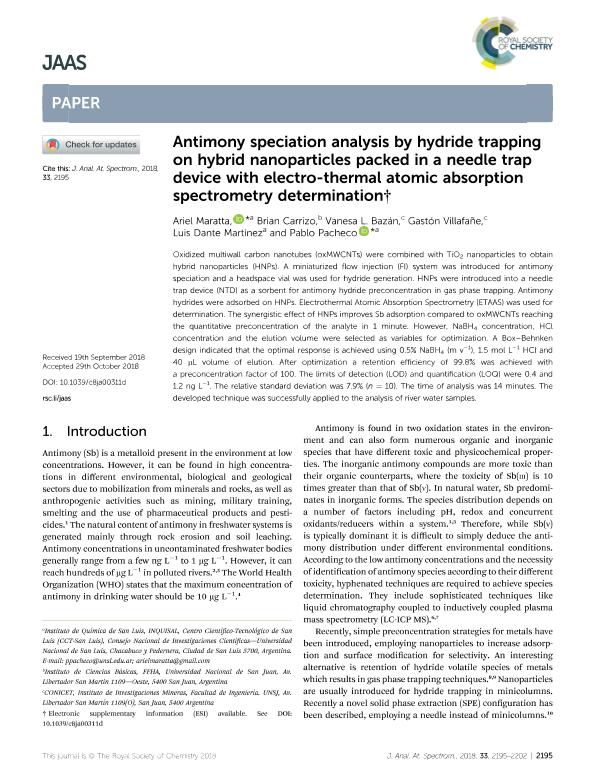Artículo
Antimony speciation analysis by hydride trapping on hybrid nanoparticles packed in a needle trap device with electro-thermal atomic absorption spectrometry determination
Maratta Martínez, Sergio Ariel ; Carrizo, Brian Gabriel; Bazan Brizuela, Vanesa Lucia
; Carrizo, Brian Gabriel; Bazan Brizuela, Vanesa Lucia ; Villafañe Salinas, Manuel Gastón
; Villafañe Salinas, Manuel Gastón ; Martinez, Luis Dante
; Martinez, Luis Dante ; Pacheco, Pablo Hugo
; Pacheco, Pablo Hugo
 ; Carrizo, Brian Gabriel; Bazan Brizuela, Vanesa Lucia
; Carrizo, Brian Gabriel; Bazan Brizuela, Vanesa Lucia ; Villafañe Salinas, Manuel Gastón
; Villafañe Salinas, Manuel Gastón ; Martinez, Luis Dante
; Martinez, Luis Dante ; Pacheco, Pablo Hugo
; Pacheco, Pablo Hugo
Fecha de publicación:
12/2018
Editorial:
Royal Society of Chemistry
Revista:
Journal of Analytical Atomic Spectrometry
ISSN:
0267-9477
Idioma:
Inglés
Tipo de recurso:
Artículo publicado
Clasificación temática:
Resumen
Oxidized multiwall carbon nanotubes (oxMWCNTs) were combined with TiO2 nanoparticles to obtain hybrid nanoparticles (HNPs). A miniaturized flow injection (FI) system was introduced for antimony speciation and a headspace vial was used for hydride generation. HNPs were introduced into a needle trap device (NTD) as a sorbent for antimony hydride preconcentration in gas phase trapping. Antimony hydrides were adsorbed on HNPs. Electrothermal Atomic Absorption Spectrometry (ETAAS) was used for determination. The synergistic effect of HNPs improves Sb adsorption compared to oxMWCNTs reaching the quantitative preconcentration of the analyte in 1 minute. However, NaBH4 concentration, HCl concentration and the elution volume were selected as variables for optimization. A Box-Behnken design indicated that the optimal response is achieved using 0.5% NaBH4 (m v-1), 1.5 mol L-1 HCl and 40 μL volume of elution. After optimization a retention efficiency of 99.8% was achieved with a preconcentration factor of 100. The limits of detection (LOD) and quantification (LOQ) were 0.4 and 1.2 ng L-1. The relative standard deviation was 7.9% (n = 10). The time of analysis was 14 minutes. The developed technique was successfully applied to the analysis of river water samples.
Archivos asociados
Licencia
Identificadores
Colecciones
Articulos(CCT - SAN JUAN)
Articulos de CENTRO CIENTIFICO TECNOLOGICO CONICET - SAN JUAN
Articulos de CENTRO CIENTIFICO TECNOLOGICO CONICET - SAN JUAN
Articulos(INQUISAL)
Articulos de INST. DE QUIMICA DE SAN LUIS
Articulos de INST. DE QUIMICA DE SAN LUIS
Citación
Maratta Martínez, Sergio Ariel; Carrizo, Brian Gabriel; Bazan Brizuela, Vanesa Lucia; Villafañe Salinas, Manuel Gastón; Martinez, Luis Dante; et al.; Antimony speciation analysis by hydride trapping on hybrid nanoparticles packed in a needle trap device with electro-thermal atomic absorption spectrometry determination; Royal Society of Chemistry; Journal of Analytical Atomic Spectrometry; 33; 12; 12-2018; 2195-2202
Compartir
Altmétricas



